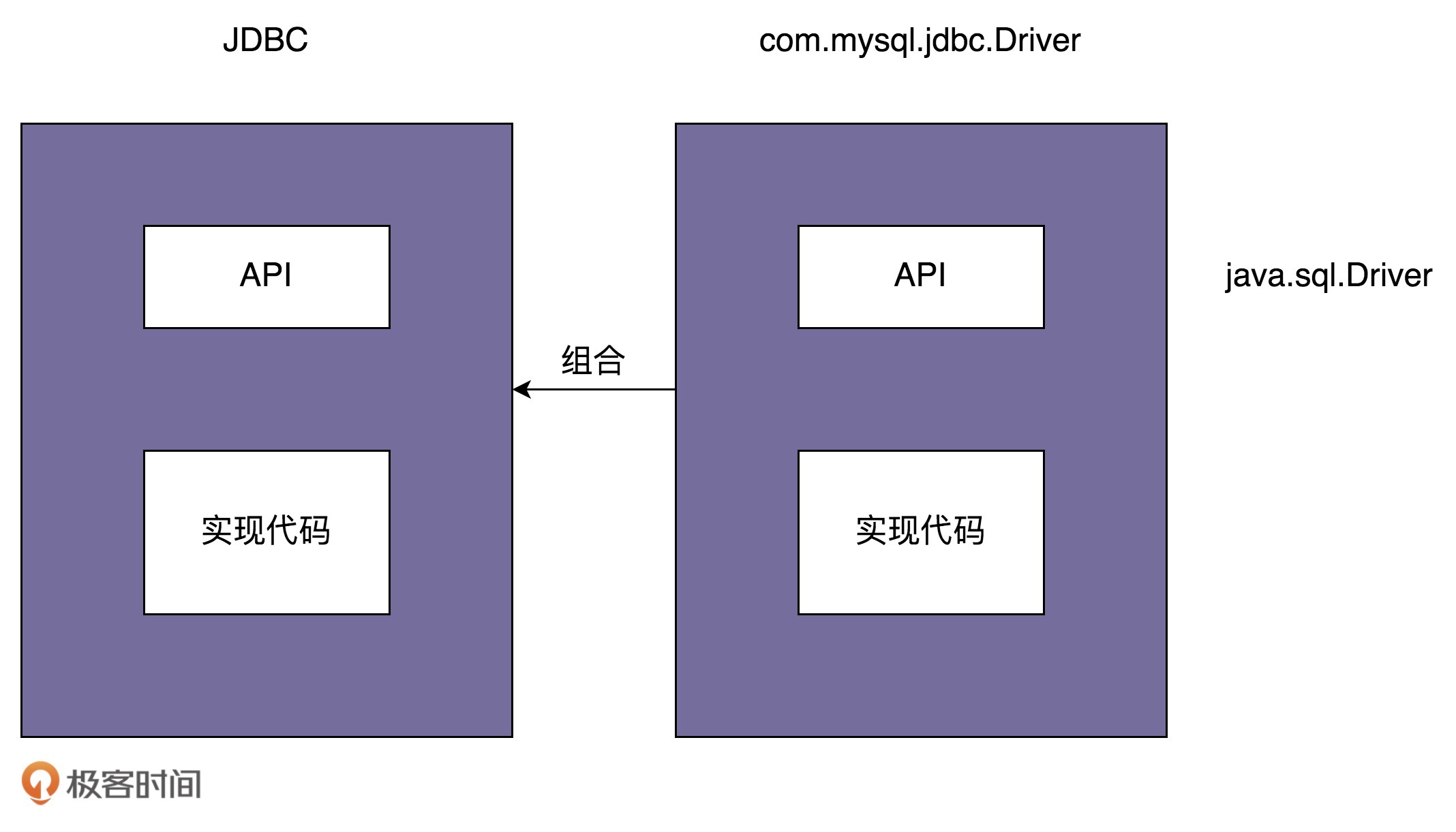桥接模式:如何实现支持不同类型和取到的消息推送系统
原理
- Decouple an abstraction from its implementation so that the two can vary independently. 将抽象和实现解耦,让他们可以独立变化。
- JDBC驱动是桥接模式的经典应用。
Class.forName("com.mysql.jdbc.Driver");//加载及注册JDBC驱动程序 String url = "jdbc:mysql://localhost:3306/sample_db?user=root&password=your_password"; Connection con = DriverManager.getConnection(url); Statement stmt = con.createStatement(); String query = "select * from test"; ResultSet rs=stmt.executeQuery(query); while(rs.next()) { rs.getString(1); rs.getInt(2); }
- 如果想使用Oracle数据库,只需要将第一行代码的driver换成OricalDriver即可。或者更灵活将driver写在配置文件,修改时只改配置文件。
- 看一下如何实现:
package com.mysql.jdbc; import java.sql.SQLException; public class Driver extends NonRegisteringDriver implements java.sql.Driver { static { try { java.sql.DriverManager.registerDriver(new Driver()); } catch (SQLException E) { throw new RuntimeException("Can't register driver!"); } } /** * Construct a new driver and register it with DriverManager * @throws SQLException if a database error occurs. */ public Driver() throws SQLException { // Required for Class.forName().newInstance() } }
- 当执行
Class.forName("com.mysql.jdbc.Driver")的时候,做了两件事,一是要求JVM查找并加载制定的Driver类,第二件事情是执行该类的静态代码,也就是将Driver注册到DriverManager类中。 - 我们再来看一下,DriverManager 类是干什么用的。具体的代码如下所示。当我们把具体的 Driver 实现类(比如,com.mysql.jdbc.Driver)注册到 DriverManager 之后,后续所有对 JDBC 接口的调用,都会委派到对具体的 Driver 实现类来执行。而 Driver 实现类都实现了相同的接口(java.sql.Driver ),这也是可以灵活切换 Driver 的原因
public class DriverManager { private final static CopyOnWriteArrayList<DriverInfo> registeredDrivers = new CopyOnWriteArrayList<DriverInfo>(); //... static { loadInitialDrivers(); println("JDBC DriverManager initialized"); } //... public static synchronized void registerDriver(java.sql.Driver driver) throws SQLException { if (driver != null) { registeredDrivers.addIfAbsent(new DriverInfo(driver)); } else { throw new NullPointerException(); } } public static Connection getConnection(String url, String user, String password) throws SQLException { java.util.Properties info = new java.util.Properties(); if (user != null) { info.put("user", user); } if (password != null) { info.put("password", password); } return (getConnection(url, info, Reflection.getCallerClass())); } //... }
在这个例子中,JDBC本身相当于抽象,一个抽象的类库, 具体的Driver相当于实现,跟具体数据库相关的类库。(这里的抽象和实现与Java中的抽象类、接口和实现类不是一个概念)。
JDBC和Driver独立开发,通过对象之间的组合,组装在一起。JDBC的所有逻辑操作委托给Driver执行。

应用举例
之前有个通过API接口监控告警的例子:根据不同柜子,触发不同类型的告警。线面针对发送信息做一些设计:
- 最基本的实现
public enum NotificationEmergencyLevel { SEVERE, URGENCY, NORMAL, TRIVIAL } public class Notification { private List<String> emailAddresses; private List<String> telephones; private List<String> wechatIds; public Notification() {} public void setEmailAddress(List<String> emailAddress) { this.emailAddresses = emailAddress; } public void setTelephones(List<String> telephones) { this.telephones = telephones; } public void setWechatIds(List<String> wechatIds) { this.wechatIds = wechatIds; } public void notify(NotificationEmergencyLevel level, String message) { if (level.equals(NotificationEmergencyLevel.SEVERE)) { //...自动语音电话 } else if (level.equals(NotificationEmergencyLevel.URGENCY)) { //...发微信 } else if (level.equals(NotificationEmergencyLevel.NORMAL)) { //...发邮件 } else if (level.equals(NotificationEmergencyLevel.TRIVIAL)) { //...发邮件 } } } //在API监控告警的例子中,我们如下方式来使用Notification类: public class ErrorAlertHandler extends AlertHandler { public ErrorAlertHandler(AlertRule rule, Notification notification){ super(rule, notification); } @Override public void check(ApiStatInfo apiStatInfo) { if (apiStatInfo.getErrorCount() > rule.getMatchedRule(apiStatInfo.getApi()).getMaxErrorCount()) { notification.notify(NotificationEmergencyLevel.SEVERE, "..."); } } }
- Notification类中有一些if-else的代码逻辑复杂。所以将不同取到的发送逻辑玻璃,形成独立的消息发送类。其中Notification类相当于抽象,MsgSend相当于实现,两者可以独立开发,通过组合关系也就是桥梁任意组合在一起。
- 所谓组合就是根据紧急程度配置发送方式。也不一定写死在代码,也可以放进配置文件。
public interface MsgSender { void send(String message); } public class TelephoneMsgSender implements MsgSender { private List<String> telephones; public TelephoneMsgSender(List<String> telephones) { this.telephones = telephones; } @Override public void send(String message) { //... } } public class EmailMsgSender implements MsgSender { // 与TelephoneMsgSender代码结构类似,所以省略... } public class WechatMsgSender implements MsgSender { // 与TelephoneMsgSender代码结构类似,所以省略... } public abstract class Notification { protected MsgSender msgSender; public Notification(MsgSender msgSender) { this.msgSender = msgSender; } public abstract void notify(String message); } public class SevereNotification extends Notification { public SevereNotification(MsgSender msgSender) { super(msgSender); } @Override public void notify(String message) { msgSender.send(message); } } public class UrgencyNotification extends Notification { // 与SevereNotification代码结构类似,所以省略... } public class NormalNotification extends Notification { // 与SevereNotification代码结构类似,所以省略... } public class TrivialNotification extends Notification { // 与SevereNotification代码结构类似,所以省略... }
思考
-
还有另外一种更加简单的理解方式:“一个类存在两个(或多个)独立变化的维度,我们通过组合的方式,让这两个(或多个)维度可以独立进行扩展。”
-
定义中的“抽象”,指的并非“抽象类”或“接口”,而是被抽象出来的一套“类库”,它只包含骨架代码,真正的业务逻辑需要委派给定义中的“实现”来完成。而定义中的“实现”,也并非“接口的实现类”,而是一套独立的“类库”。“抽象”和“实现”独立开发,通过对象之间的组合关系,组装在一起。
对于第二种理解方式,它非常类似我们之前讲过的“组合优于继承”设计原则,通过组合关系来替代继承关系,避免继承层次的指数级爆炸。